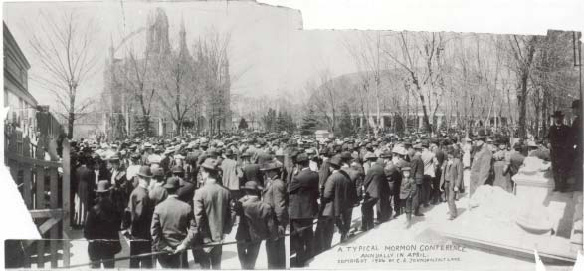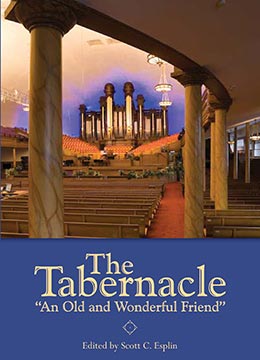Social and Economic Effects of the Tabernacle
Scott C. Esplin, “Social and Economic Effects of the Tabernacle,” in The Tabernacle: “An Old and Wonderful Friend” (Provo, UT: Religious Studies Center, Brigham Young University, 2007), 241–8.
At the time of its completion, the Tabernacle was the outstanding feature of Salt Lake City. It dominated its surroundings. At the first conference held in the Tabernacle, Elder Orson Pratt described the thoughts and suggestions which were brought to his mind by the appearance of the Tabernacle as he caught his first view of it from the mountains as he returned from his mission: “It seemed to rear itself up above the surrounding buildings, . . . like an artificial mountain erected here, or like some of those mounds that we see down on the Missouri River that were made by the ancient inhabitants of our country.” He also said, “I am forcibly reminded of the sayings of two of the ancient prophets, Isaiah and Micah . . . ‘the mountain of the House of the Lord shall be established in the tops of the mountains.’”[1]
Just as the Tabernacle was the dominant building in the area, so it became a dominant factor in the social and cultural life of Utah; and although church buildings are rarely thought of as having important economic significance, the Tabernacle has had a great economic effect.
Social and Cultural Effects
The religious significance of the Tabernacle is evident. It is a central meeting place for the Saints. At the Tabernacle they can receive significant religious teachings and confirm the important actions of their religious leaders.
As a social and cultural influence, the Tabernacle has been outstanding since it was first completed. One such effect has been upon the Mormon people themselves through their religious services. At these services the organ music and choir numbers have been of an unusually high standard. Listening to such music has increased the Mormon people’s appreciation for good music and has set a high goal for achievement in their local groups. These local choirs and other groups are invited on occasion to participate in the services in the Tabernacle, and thereby the cultural level of that group is raised through the motivation of appearance in the Tabernacle. It should also be pointed out that all of the singers of the Mormon Tabernacle Choir are unpaid volunteers. The thousands who throughout the years have joined the choir and received musical instruction have been a notable influence in raising the cultural level of the entire populace of the area.
The second means whereby the Tabernacle has been a potent cultural influence is through its use as a concert and lecture hall. The Saints since their pioneer days have prided themselves on taking a high degree of interest in culture, and many great musicians have appeared in the Tabernacle. The remarkable acoustics of the building have elicited the comment of many. Adelina Patti, after singing there, remarked: “Never have I encountered such perfect resonance as here in the Tabernacle. Why, my voice is twice as large here. It carries farther and with ever so much more tone than in any hall that I have ever sung in.”[2]
The importance of the Tabernacle as a concert hall has increased throughout the years. Improved transportation has resulted in a greater number of famed singers, instrumentalists, orchestras, and other performers of merit appearing there. The Tabernacle still forms one of the great musical centers for Salt Lake City and the surrounding area.
As a lecture hall, the Tabernacle has served an equally important function in the life of the people of the area, both Mormon and non-Mormon. It was in the Tabernacle that many prominent non-Mormon preachers had the opportunity to express their religious and social views. The author at one time attended a meeting there at which all of the major religions of the area were represented by their religious leaders, and all were given opportunity to present their views. The Tabernacle has also been the center for the appearance of famed professional lecturers on various subjects. The fact that the Tabernacle was made available for such activities and can seat approximately ten thousand people made it one of the great lecture halls of the nation at that time. As of 1947, seven presidents of the United States, many vice presidents, and other prominent men in government had appeared there.
The third medium through which the Tabernacle has brought culture to its own area and people, but also has had an effect far beyond the local group, is through the famed organ and choir broadcasts over national and international networks. These broadcasts have been presented continually for many years and are heard by millions each week. Critics are unanimous in the approval of these broadcasts as being of the highest musical and cultural value. In addition to the radio and satellite broadcasts, daily organ recitals (except on Sundays) are presented at the Tabernacle during the summer season. All tourists, visitors, and others are invited free of charge. The author attended such a recital Monday, August 11, 1947. There were at least three thousand persons present, most of them tourists. Many of them were drawn by the fame of the building and the organ, and others were seeking genuine musical enjoyment. Whatever the reason for attending, they were elevated by a fine musical performance.
William Allen White, the renowned Kansas editor, was quoted in Pathfinder Magazine as having said that the American culture had reached its highest point in Utah and the Valley of the Great Salt Lake. The Mormons think that his statement is justified and are proud of their cultural attainments in what has been considered an area remote from the major cultural centers of the world. But whatever cultural level the Mormons have attained, their achievement has been greatly influenced by the presence of the Great Tabernacle and its organ.
Economic Effects
The first economic effect of the Tabernacle was to provide employment for a large number of people. At the time of its building, it represented a major construction enterprise and was of considerable economic significance. The wage level for work on the Tabernacle was high. The two dollars, three dollars, and three dollars and fifty cents per day paid to the workmen were comparatively high wages at the time.
The second economic effect was to increase the size of the conference crowds. Conference in The Church of Jesus Christ of Latter-day Saints had always meant a great influx of people from the surrounding communities with the resulting increase in business of the Salt Lake City merchants. With the completion of the Tabernacle, this influx was greater and the consequent trade in Salt Lake City during the conference period was increased. Special trains were run for conference visitors and special rates provided for them. Brigham Young commented on this in a letter he wrote to Albert Carrington who was in England. The year was 1870:
It is estimated that 11,000 or 12,000 persons may be comfortably seated in the New Tabernacle this Conference. Special trains will run during Conference from within 1 ½ miles of Brigham City, over the C.P.R.R. to Ogden and the U.C.R.R. to this city. The C.P. Company intend to build permanent switches and stations at Brigham and Willard Cities for the accommodation of our people, which will facilitate communication with our northern settlements quite extensively.[3]
The economic effect which the conferences have had on business in Salt Lake City is shown in the following:
The general conferences of the church, annual and semiannual, during the troubled years of 1885 and 1886, and the April conference of 1887, were held in other places than Salt Lake City. Two were held in Logan, two in Provo, and one in Coalville, Summit county.
This action on the part of the church authorities met with loud protests from the Gentile merchants of Salt Lake City. . . . At these annual and semi-annual conferences the Salt Lake merchants, Gentile as well as “Mormon,” reaped a regular annual and semi-annual harvest of trade. Literally thousands of people, many of them from the remotest settlements of the saints . . . came regularly to Salt Lake City to do their spring and fall shopping, induced thereto by the reduced railroad rates for the conference.[4]
These conference visitors remain a major factor in merchandising in Salt Lake. Although their importance diminishes as the size of Salt Lake increases, the merchants still slant their advertisements to catch the eye of the conference visitor.
 View from the steps of the Bureau of Information looking northwest, with the Salt Lake Tabernacle and Assembly Hall in the background. This photo of the April 1906 general conference shows the large numbers that typically flocked to Temple Square looking for a seat at the conference.
View from the steps of the Bureau of Information looking northwest, with the Salt Lake Tabernacle and Assembly Hall in the background. This photo of the April 1906 general conference shows the large numbers that typically flocked to Temple Square looking for a seat at the conference.
Probably the greatest modern economic significance of the Tabernacle is as a tourist center. From its earliest days the Tabernacle has been a major point of tourist interest; and with modern facility of travel, and the fame of the Tabernacle spread by the musical broadcasts, the interest has broadened. Early tourist guides mentioned the Tabernacle. Crofutt’s New Overland Tourist, published in 1878, is typical:
The Tabernacle—an immense building—is the first object one beholds on entering the city. The building oblong in shape, having a length of 250 feet from east to west, by 150 feet in width. The roof is supported by 46 columns of cut sandstone, which, with the spaces between, used for doors, windows, etc., constitute the wall. From these pillars or walls, the roof springs in one unbroken arch, forming the largest self-sustaining roof on the continent, with one notable exception—the Grand Union Depot erected by the late Commodore Vanderbilt in New York.[5]
During the tourist season of 1946, over one million tourists visited the Tabernacle. The tourist traffic was so heavy around the Temple Block that two entire blocks were set aside as a parking area for out-of-state cars only. The tourist trade, it is evident, is a prime factor in the economics of Salt Lake City. Most tourists hurry through other Utah towns but make a prolonged stop in Salt Lake in order to visit the Temple Block and attend an organ recital in the Tabernacle.
Indicative of the large part played by the Tabernacle in the economic life of Salt Lake was an article which appeared in the Salt Lake Tribune, May 18, 1947, in which it was reported that Ogden businessmen had commented that Ogden would now be the largest city in Utah if it were not for the location of the Temple Square and the headquarters of the Church in Salt Lake City. Ogden, they pointed out, has all of the commercial advantages of transcontinental railway lines and other factors, yet Salt Lake continues its rapid growth, influenced to some extent by the economic factors indicated above.
Notes
[1] Journal History, October 7, 1867.
[2] Levi Edgar Young, The Great Mormon Tabernacle with its World-Famed Organ and Choir (Salt Lake City: Bureau of Information, 1917), 23.
[3] “Correspondence,” Millennial Star, May 24, 1870, 330.
[4] B. H. Roberts, Comprehensive History of the Church of Jesus Christ of Latter-day Saints (Salt Lake City: Deseret News, 1930), 6:169.
[5] George A. Crofutt, Crofutt’s New Overland Tourist and Pacific Coast Guide (Chicago: Overland, 1878), 125–26.
